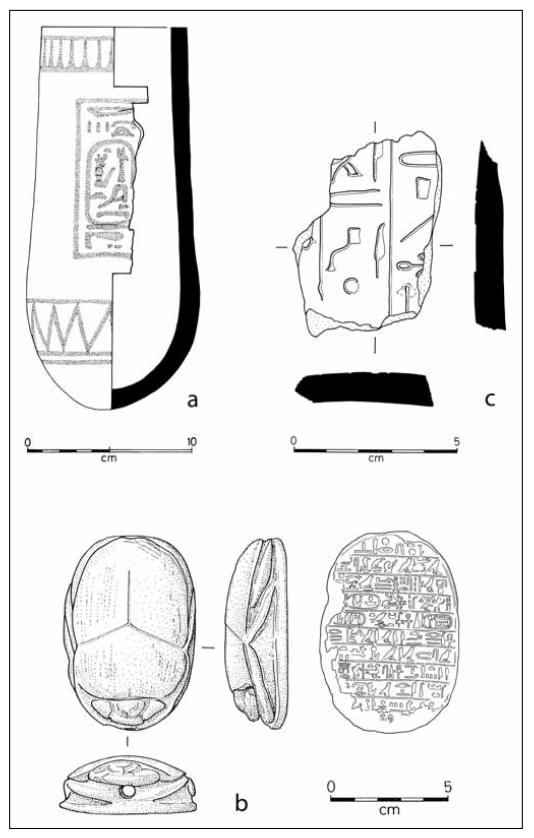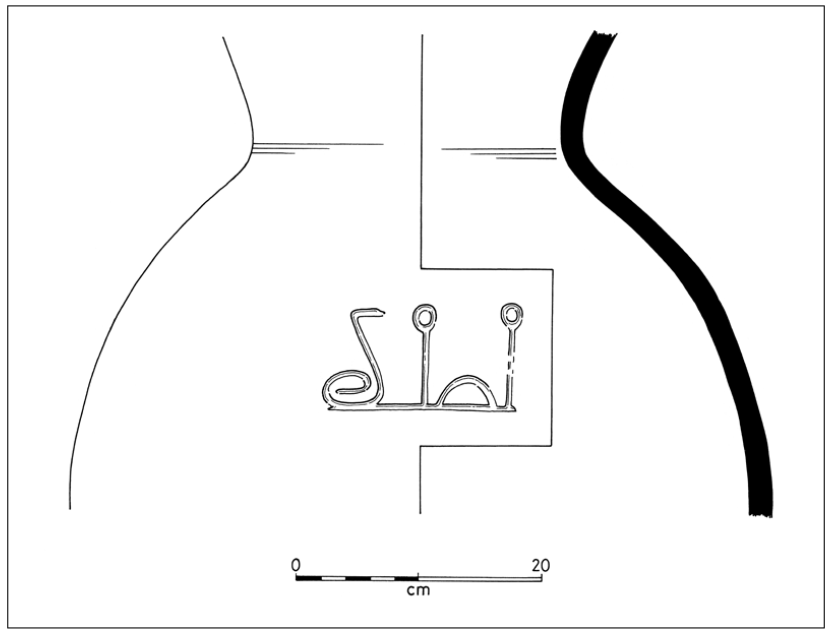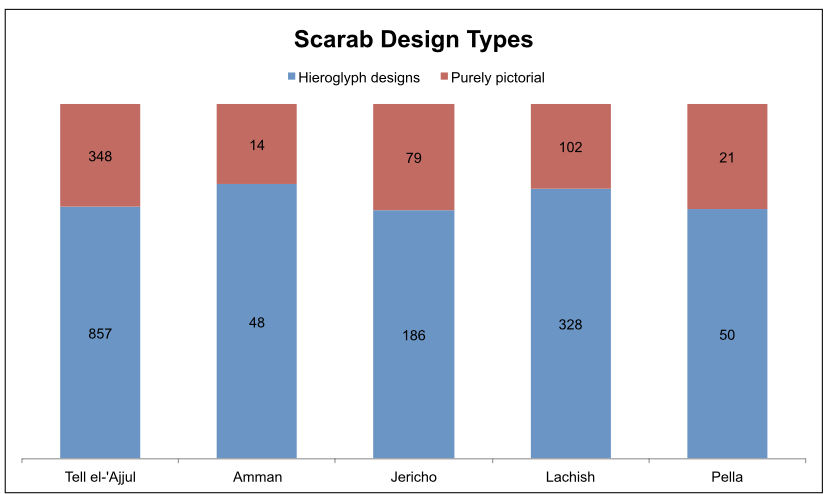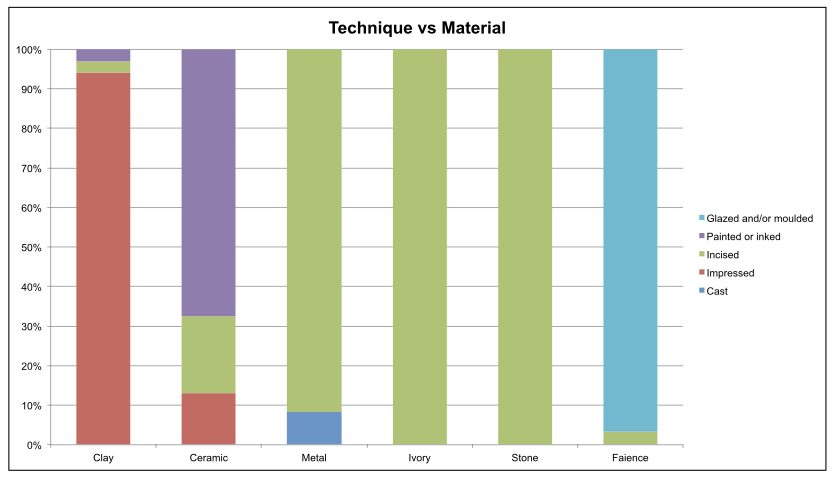A review of the types of writing found in the Southern Levant during the Middle and Late Bronze Ages underlines one fact: textual evidence is much rarer in this region than contemporary Egypt, Syria-Lebanon or Mesopotamia. There is a dearth of significant deposits of clay tablet archives or sealings, and the organic materials on which so much ancient writing was probably carried out, such as wood, leather and imported papyrus are only rarely preserved. Even within the materials that have survived, there are further problems with chronology and context, as many examples are poorly provenanced, making it difficult to pinpoint exactly when various developments in palaeography or technique took place. The fact that these data are both statistically insignificant and heavily biased towards certain types of materials makes it something of a challenge to establish how and when different types of script were introduced into the area and the ways in which they were subsequently used, and there is the constant risk that we may have to ‘rewrite’ our understanding of these processes as fresh evidence comes to hand. Most studies that have been done on writing in the region have been quite specialised, focusing on particular scripts and tending to concentrate on aspects of language rather than the way in which writing is created and used. In particular, the material aspects of this technology have rarely been addressed. This has served to obscure its overall range and diversity.
There are currently around 61 cuneiform texts attributable to the Bronze Age (recording Sumerian, Akkadian, and West Semitic languages; Horowitz et al. 2006), three in alphabetic cuneiform, some 17 Proto-Canaanite examples (Sass 1988; Hamilton 2006; 2010), six in Hittite hieroglyphic (Singer 1977; 1993; 2003) and two probable examples of Aegean scripts (this figure excludes pot-marks based on the known Cypro-Minoan syllabary, as their identification as writing can be questioned: Cross and Stager 2006; Dothan 1979: 12, fig. 15). Hieratic is represented by at least 21 objects. However the most common group of texts are in Egyptian hieroglyphic; at least 118 examples are known, across a wide range of object types, and the figure explodes into the thousands if one includes the texts moulded or incised onto personal scarabs. Two examples of the less common cursive form of hieroglyphic complete the known repertoire of script forms. No single catalogue of either hieratic or hieroglyphic texts from the region has ever been published, but various studies have dealt with differing aspects of both (Eggler and Keel 2006; Goldwasser 1984; Keel 1997; Maeir et al. 2004; Mumford 1998; Porter and Moss 1952; Sweeney 2004). A summary of script and language diversity may be found in Figures 1–2.
While the linguistic demands of each speciality make a focus on individual scripts understandable, it is worth revisiting the phenomenon of writing in the region in a more holistic fashion, considering what archaeology can contribute to current debate through a study of the materiality of script use, and how this relates to the needs of different individuals and communities. This perspective raises new questions, including what types of materials and objects are used to carry writing, how script size, shape, location and so on inform use and meaning, where such inscribed objects are found, and what these material features and archaeological contexts can tell us about who is using them.
In Middle Bronze Age Canaan, the evidence for use of script is both limited, and mixed in nature. Cuneiform is poorly represented by discoveries of clay tablets at sites such as Hazor and Shechem, clay liver models and appearances on a ceramic jug, and on stone and clay cylinder seals of this period (Horowitz et al. 2006: 46, 65–80, 83–85, 88–91, 95, 121–123). The technique of execution depends on the material being utilised; signs are generally impressed on clay and incised into stone. An exception is a ceramic jug from Hazor, where a cult symbol was drawn in the clay before firing and an Akkadian personal name scratched into the surface afterwards (Horowitz et al. 2006: 65–66). The former points to an intent to use the vessel for cult purposes at the point of production, while the latter points to additional customisation at some later stage. Proto-Canaanite appears sporadically, incised and impressed onto ceramic vessels before firing and cut into the surface of a bronze dagger (Sass 1988: figs 140, 143, 271), and there is a single Minoan graffito on a sherd from Tel Haror (Oren et al. 1996). Egyptian hieroglyphic texts of this period are best represented on scarabs and are usually carved into the surface; there are also a few clay bullae, a carnelian bead and a faience cylinder seal (Giveon 1985: 108, no. 138; Keel 1997: 116, cat. 39; Petrie 1930: pl. 10, no. 111; Ussishkin 2004: fig. 23.40.2). Inscribed stone statuary produced at this time would appear to have been looted from Egypt and brought to Canaan at a later date (Weinstein 1975). Cursive hieroglyphs or hieratic script do not yet appear to have been introduced to the region.
During the Late Bronze Age the frequency and range of both scripts and language increases, as does the variety of objects on which text appears. When Canaan was conquered and incorporated into the Egyptian empire, a process formalised with the introduction of Egyptian administrative control during the reign of Tuthmes III (1479–1429 bc), the result was both to reinforce already existing markets for use of writing and to create a whole series of new audiences. Particularly important with regard to the latter was the need to provide efficient communication between Egypt and her new vassals. The language and script of international diplomacy, Akkadian cuneiform, already in use between Near Eastern governments, was now pressed into use for communication with Egypt as well, by means of the traditional clay tablet (Goren et al. 2004; Millard 1999: 317–318, figs 1–2; Moran 1992).
At the same time, changes in the way the region was managed led to the establishment of Egyptian- run garrisons and administrative centres at key locations, such as Gaza, Deir el-Balah and Beth Shan. Their roles included providing logistical support for the empire, provisioning troops and other Egyptians stationed there or moving through on official business, controlling local security, and organising local corvée labour from Canaanite settlements. Managed by Egyptians, we suspect these centres made use of Egyptian hieratic to support many of these activities, although only a few texts inked onto ceramic vessels and sherds have survived. Vessels were also the primary surface material for hieratic votive and religious texts, predominantly added to the surface in ink or paint after firing. Hieroglyphs appear to be used in a wider range of settings. Stamps bearing cartouches were impressed onto storage jars before firing, from the co-regency of Hatshepsut and Tuthmes III onwards, probably to mark the property of royal estates (Higginbotham 2000: 254; Figure 3); they were carved into the surface of stone architectural elements, statuary and stele, incised into elite ivory objects such as musical clappers, pen cases and furniture inlays, or metal signet rings, and included in the glazed designs of faience vessels and votive objects, while the popularity of scarabs continued. This was a market driven by a combination of Egyptian imperial policy, increasing numbers of Egyptians working in the region, and a desire to emulate Egyptian visual styles amongst Canaanite elites. The sum total of these varied spheres of use would have been that Egyptian writing was much more visible to the local population than ever before.
In addition to these developments, the alphabetic Proto-Canaanite script continued to be used sporadically amongst local elites, most probably recording a local West Semitic language, although the shortness of most inscriptions makes clear identification difficult. It is applied to a range of personal items, including a gold signet ring, and ceramic bowls, jugs, a lidded pyxis and spouted cup (Hamilton 2010; Sass 1988: 101, figs 143–147, 156–160, 163–167, 178–184, 268–270; Figure 4). Inscriptions were painted or incised both before and after firing with all this implies for the agency behind the text. The signs are often cursive in character using either technique, but occasionally when incised are rendered in a more linear fashion. They appear in tombs, temples and as domestic refuse, pointing to a wide range of contextual settings. Tablets written in Proto-Canaanite have not been found. This script appears to have been used in a less formal and managed way than either cuneiform, Egyptian hieroglyphic or hieratic.
Additional foreign scripts make a sporadic appearance. A clay bulla with an impressed royal Hittite seal was found at Aphek, where it had been discarded in a building thought to be used by a local administrator (Goren et al. 2006); the remaining Hittite texts are inscribed into either metal or stone and served as personal seals and signet rings (see below), perhaps representing sporadic diplomatic activity. Finally, there is a limestone bowl with a capacity inscription cut into the exterior upper walls in a script that is possibly Linear A (Finkelberg et al. 2004).
The following discussion will attempt to review the evidence for Bronze Age writing, in all its material forms, according to the role it may have played within local communities. This involves dividing the evidence into a number of categories: uses for administration and information management, communication, education, diplomacy and politics, to support religious beliefs (funerary, votive and protective) and to mark ownership. These categories are a useful tool, although it should be noted that official and private uses may have sometimes overlapped and at times be difficult to categorise. This study has been deliberately limited to the distribution of texts in the Southern Levant (modern Israel, Palestinian Authority and Jordan), as quite different circumstances may have been operating on cities further north, such as Byblos, with its particular links to Egypt, or Ugarit, a trading entrepôt with an unusually cosmopolitan nature due to its physical location on the interface between the Near Eastern and Mediterranean spheres. Core data used in charts and tables has been drawn from material that can be dated to the Middle and Late Bronze Ages only. It excludes material whose identification or chronology is uncertain, and texts compris- ing a single sign, which may have functioned as identification marks or symbols rather than writ- ing. Scarabs and scaraboids were also excluded from statistical comparisons, as the data set was too large to be included; a smaller case study of some aspects of this material has however been incorporated. A chronological chart of the periods covered by this chapter may be found in Table 1, and a map showing sites under discussion in Figure 5.

Figure 1: Script diversity in the Southern Levant c.2000–1150 bc. This data excludes pot marks and hieroglyphic-shaped amulets, as it is debatable whether these functioned as writing rather than as symbols or markers. It also excludes hieroglyphic and pseudo-hieroglyphic scarab and seal inscriptions, because the quantity of objects involved would be overwhelming and obscure other patterns in the material.

Figure 2: The diversity of languages represented by Bronze Age texts found in the Southern Levant.

Figure 3: Ceramic storage jar with impressed stamps bearing cartouches containing the names of Tuthmes III and Hatshepsut in Egyptian hieroglyphic. UCL Institute of Archaeology Collections EXIII.112e/21.

Figure 4: Ceramic spouted cup (spout now missing) from Tell el-‘Ajjul Tomb 1109, with painted Proto-Canaanite ownership inscription reading: ‘this (belongs) to Yrṣ’, (the) Can[aan]ite’ (Hamilton 2010: 107). UCL Institute of Archaeology Collections EXIII.115/1.
| Middle Bronze I |
2000-1750 BC |
| Middle Bronze II |
1750-1650 BC |
| Middle Bronze III |
1650-1550 BC |
| Late Bronze I |
1550-1400 BC |
| Late Bronze II |
1400-1150 BC |
| Iron Age |
1150-520 BC |
Table 1: Chronological chart of the Southern Levant.

Figure 5: Map of sites discussed in the text.

Figure 6: Clay liver model fragment from Hazor with impressed cuneiform inscription (after Landsberger and Tadmor 1964, and Horowitz et al. 2006: 209).

Figure 7: Objects with Egyptian hieroglyphic inscriptions. a) Faience vessel with cartouches of Tausret from Deir ‘Alla (after Franken 1992: figs 3–9.5); b) Commemorative scarab of Amenhotep III from Beth Shan (after Goldwasser 2002: 192); c) Calcite canopic jar fragment from Tell el-‘Ajjul. UCL Institute of Archaeology EXIII.117/1.

Figure 8: Jar with incised cursive hieroglyphs from Beth Shan VII (after James and McGovern 1993: fig. 11.4).

Figure 9: Bowl with painted hieratic inscription from Lachish (after Sweeney 2004: fig. 24.2).

Figure 10: A comparison of scarabs with purely pictorial designs and those incorporating hiero-glyphic signs from selected South Levantine sites.

Figure 11: Faience bead necklace with carnelian udjet amulet, from Tell Fara Tomb 949, dating to the Late Bronze Age IIB. UCL Institute of Archaeology Collections EVI.23/16.
| Amulet Form |
Tomb |
Temple |
Other |
Totals |
| Nefer |
30 |
6 |
0 |
36 |
| Udject |
6 |
4 |
3 |
13 |
| Djed |
1 |
22 |
2 |
25 |
| Hst |
0 |
12 |
0 |
12 |
| Tit |
0 |
16 |
1 |
17 |
| Ib |
0 |
2 |
0 |
2 |
| Heh |
0 |
7 |
0 |
7 |
| Ankh |
0 |
1 |
4 |
5 |
| Total |
37 |
70 |
10 |
117 |
Table 2: The comparative frequency of Egyptian hieroglyph-shaped amulets according to context type (based on data from McGovern 1985: 125–259, and James and McGovern 1993).

Figure 12: Silver finger ring with incised Hittite inscription, bearing the personal name Ana. UCL Institute of Archaeology Collections EVI.64/8.

Figure 13: This chart shows the different ways in which texts can be added to objects, and how these techniques relate to script choice.
 Figure 14: Writing technique can relate to the physical properties of the surface being written upon. This chart shows how technique and material relate to one another across the range of Bronze Age South Levantine texts.
Figure 14: Writing technique can relate to the physical properties of the surface being written upon. This chart shows how technique and material relate to one another across the range of Bronze Age South Levantine texts.
| |
Administrative |
Education |
Propaganda |
Funerary |
Votive |
Protective |
Ownership |
| Cuneiform |
X |
X |
|
|
X |
|
|
| Alphabetic cuneiform |
X |
|
|
|
X |
|
X |
| Proto-Cananite |
? |
|
|
|
X |
|
X |
| Egyptian Hieroglyphs |
X |
|
X |
X |
X |
X |
|
| Hieratic |
X |
|
|
|
X |
X |
|
| Cursive Hieroglyphs |
|
|
|
|
X |
|
|
| Hittite Hierogrlyphs |
X |
|
|
|
|
|
X |
| Aegean |
X |
|
|
|
X |
|
X |
Table 3: The relationship between script and its context of use, as determined by evaluating the object type and function, alongside the content of the text itself.
















 Figure 14: Writing technique can relate to the physical properties of the surface being written upon. This chart shows how technique and material relate to one another across the range of Bronze Age South Levantine texts.
Figure 14: Writing technique can relate to the physical properties of the surface being written upon. This chart shows how technique and material relate to one another across the range of Bronze Age South Levantine texts.